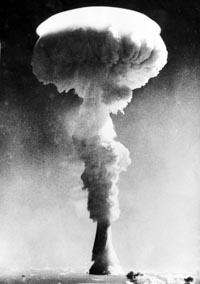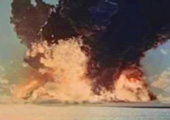 |
|
Britains's Nuclear Weapon Program
"We've got to have it and it's got to have a bloody Union Jack on it..."
- Ernest Bevin, UK Foreign Secretary 1946
|
Great Britain became the third nuclear power when it successfully detonated an atomic device in October 1952 during Operation Hurricane. Great Britain is one of the five nuclear-weapon states (NWS) recognized by the Nuclear Non-Proliferation Treaty, which was ratified by the UK in 1968. Between 1952 to 2006, Britain had built approximately 1,200 nuclear weapons. Britain currently stockpiles 185 nuclear weapons; the peak number of warheads stockpiled was 410 in 1969.
Still recovering from World War II, Britain developed a nuclear arsenal independent of foreign aid and during a time of national shortages. The primary motivation for the development of nuclear weapons was to retain an effective and independent deterrent against Soviet aggression which would contribute to the strength of Western defense. Being the only European member of NATO with nuclear weapons, Britain gained political leverage in Anglo-American relations which it had lost following the war.
Though initially independent of the United States, Britain would sacrifice her nuclear arsenal in the late 1950s for increased cooperation with the United States in nuclear weapons research, development, and deployment. The 1958 US-UK Mutual Defence Agreement effectively put an end to Britain's independent nuclear deterrent in favor of anglicized versions of existing American weapons, such as the Mk-28. With the reopening of US-UK nuclear cooperation, Britain had access to nuclear weapons much more quickly and cheaply than had she retained her independent arsenal.

GRapple Y (08/11/1957)
|
Despite ultimately having little to show for her efforts after World War II, Britain's nuclear weapons program helped secure and maintain an alliance with the United States which had faltered in the early, uncertain years of the Cold War.
"We have made a successful start. When the [nuclear] tests are completed, as they soon will be, we shall be in the same position as the United States or Soviet Russia. We shall have made and tested the massive weapons. It will be possible then to discuss on equal terms. "
- Harold Macmillan, Prime Minister 1957
|
Nuclear cooperation between Great Britain and United States ceased after World War II due to the passing of the McMahon Act of 1946, which restricted the sharing of nuclear technologies between nations. Great Britain, which had made great contributions to America's nuclear weapons program during the war, was galvanized and saw the act as betrayal on the part of the United States.
Britain's newly elected Labour Prime Minister Clement Attlee initiated the independent development of nuclear weapons shortly after the war; by January 1947, the decision to pursue nuclear arms was made official, though much progress had already been made up to that time. Dr. William George Penney, who assisted the United States in the development of nuclear weapons during the Manhattan Project, was made responsible for the early British atomic weapons research program.
In November 1946 Penney initiated plans for the development of an Atomic Weapons Section; which would initially be code named HER (High Explosives Research). In May 1947 Penney was officially made head of the HER project, which was based at the Woolwich Arsenal. With the recruitment of scientists and engineers the project would grow greatly; this created several logistical problems as the program was spread across a number of test facilities across the UK. In April 1950 a central base for atomic weapons research was established at an abandoned airfield, called Aldermaston, in Berkshire. Officially named the AWRE (Atomic Weapons Research Establishment), this would become the permanent home of Britain's nuclear weapons program.

Hurricane (03/10/1952)
|
In 1952, Britain successfully detonated an atomic device off the Western coast of Australia at the Monte Bello Islands. Code named Operation Hurricane, a plutonium implosion device was detonated on a ship with a yield of 25 kilotons. Upon his return to England after the successful test, Dr. Penney received a knighthood from Queen Elizabeth II.
"Conditions of extreme self defense are extraordinarily difficult to contemplate but we must reserve the right to use our nuclear weapons in those circumstances, otherwise clearly they cannot act as the deterrent that they are."
- Minister of Defense Geoff Hoon
|
Following the success at Monte Bello, Britain became committed to developing an effective and reliable nuclear arsenal. Operation Totem, the second series of nuclear tests, was conducted in 1953 in Australia. Totem was the first weapons development test series conducted by Britain, aimed at gaining further knowledge in the design of fission weapons. In 1957, Britain would explode a hydrogen bomb, securing her place as one of the top world powers. The test was conducted under Operation Grapple, which was the largest military operation conducted by Britain since World War II. As with Britain's first fission weapons, thermonuclear weapons were developed without any U.S. assistance.
Today, Britain retains a nuclear arsenal compromised of about 185 nuclear warheads. Since the withdrawal of the WE.117 nuclear gravity bomb in 1998, Britain's nuclear deterrent has been deployed exclusively on the Royal Navy's fleet of nuclear-powered ballistic missile submarines and their accompanying Trident submarine-launched ballistic missiles. The following section presents a historical overview of Britain's nuclear weapons program. Information on these pages includes the early stages of nuclear weapons research, detailed analysis of Britain's nuclear testing program, and overviews of Britain's nuclear arsenal both past and present.
British Nuclear Testing in Australia
No suitable nuclear test site could be established in Britain due to the islands' relatively small land area and dense population. Initially it was hoped that the United States would allow Britain the use of the Nevada Test Site or Pacific Proving Grounds, but this was rejected due to the escalating Cold War and ban on the sharing of nuclear technologies. Britain looked elsewhere to test her nuclear weapons, with the most interest being in Australia. Several locations in Australia were considered, including Groote Eylandt in the Gulf of Carpentaria and an island in the Bass Strait off Tasmania.

Kite R3 (11/10/1956)
|
In 1950 British Labor Prime Minister Clement Atlee secretly asked Australia Prime Minister Robert Menzies for the use of Australian soil for the testing of British nuclear weapons. Menzies, who wanted an Australia nuclear weapons program, agreed under the terms that Britain would share nuclear technologies with Australia. However, political conditions at the time prevented the sharing of technologies, specially a reactor, with Australia on the grounds that it would upset UK-US relations.
The Monte Bello Islands were chosen as the new test site and a preliminary assessment of the suitability of the proposed site was conducted in October-November 1950. British authorities deemed the site suitable for a nuclear test and on March 26, 1951 a formal request was made by Atlee for the its use. The reply was delayed till after the 1951 elections, which was won by the Menzies government. With the approval of the Australian government, Britain's first nuclear trial, code named Operation Hurricane, was conducted in Western Australia. Public announcement of the nuclear test was made on February 19, 1952 and Hurricane was detonated later that year on October 3, 1952.
Following Hurricane the British government, now lead by new Prime Minister Winston Churchill, inquired about the use of a test site in Southern Australia for further nuclear testing. In December 1952, Churchill asked Menzies about the use of Emu Field, 744 miles northwest of Adelaide in the Great Victoria Desert, for two experimental nuclear tests, codenamed Operation Totem. Menzies again gave permission for the tests and in the fall of 1953 two nuclear devices were detonated at Emu Field, with yields of 10 and 8 kilotons respectively.
By now Britain was fully committed to developing a nuclear deterrent and asked the Australian government for the establishment of a permanent nuclear test site in South Australia. Three days after Operation Totem the Australian government was advised about the possibility of establishing a permanent nuclear test site and in August 1954 the Australian Cabinet agreed to the establishment of the Maralinga Test Range. Emu Fields was deemed to be too remote for extensive nuclear trials so Maralinga, north of the transcontinental railway line in South Australia, was chosen.
Two years would pass before the next series of British nuclear tests in Australia, code named Operation Mosaic. Mosaic was an experimental thermonuclear weapons series conducted at the Monte Bello Island in mid-1956. Following Mosaic the first nuclear tests were conducted at Maralinga as part of Operation Buffalo in September-October 1956, followed by the Antler trials in 1957.
The Grapple Trials
Operation Grapple was Britain's program to test a hydrogen bomb. The operation was the largest British combined military operation since World War II and was conducted without any American aid. The development of experimental and unproven thermonuclear devices at Aldermaston necessitated their testing. Christmas Island was chosen as the main site for the Grapple trials between 1957 to 1958. Six nuclear detonations took place off the coast of Christmas Island and three over Malden Island.
While thermonuclear concepts were already being testing in 1956 during Operation Mosaic in Australia, Grapple's main objective was to test a “one ton/one megaton” bomb. These new weapons would be efficient, hardened, multi-staged thermonuclear weapons capable of being deployed both on strategic nuclear bombers as well as on strategic nuclear missiles.
Nuclear Arsenal
The United Kingdom has a stockpile of approximately 160 operational nuclear warheads. These are deployed on a fleet of four Vanguard Class Trident SSBNs. About 58 Trident II (D-5) are leased from the United States Navy. A single British SSBM will be on patrol at any given time; this submarine carries up to 48 warheads on 16 D-5 missiles. The second and third SSBNs can be deployed on short notice with similar loadings. Since the end of the Cold War, the SSBN on patrol is maintained at a level of reduced readiness with a “notice to fire” measured in days, the missiles are de-targeted.
The Ministry of Defence has confirmed that it is considering a range of options for replacement of the Trident system. These replacements include land and air-based delivery systems, as well as submarines. In July 2005, the Ministry of Defence announced a new, three year £1.05 billion investment to upgrade the Trident missile warhead facilities at the AWE. The purpose of this investment is to ensure that the existing Trident warhead stockpile is reliable and safe, and that is can be maintained throughout its intended service lifetime.
|
|
|
 |





